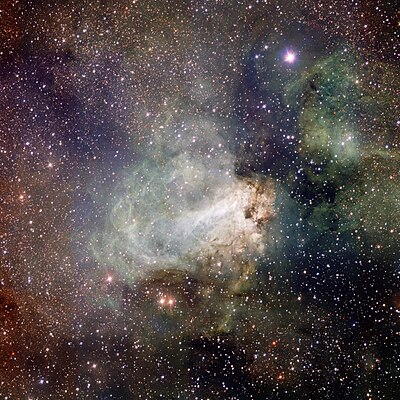|
| This It is of interest to the following WikiProjects: | |||||||||||||
| ||||||||||||||
Hello fellow Wikipedians,
I have just modified one external link on Omega Nebula. Please take a moment to review my edit. If you have any questions, or need the bot to ignore the links, or the page altogether, please visit this simple FaQ for additional information. I made the following changes:
- Added archive https://web.archive.org/web/20070930030807/http://www.spacetelescope.org/bin/images.pl?embargo=0&viewtype=standard&searchtype=freesearch&lang=en&string=M17 to http://www.spacetelescope.org/bin/images.pl?embargo=0&viewtype=standard&searchtype=freesearch&lang=en&string=M17
When you have finished reviewing my changes, you may follow the instructions on the template below to fix any issues with the URLs.
This message was posted before February 2018.
After February 2018, "External links modified" talk page sections are no longer generated or monitored by InternetArchiveBot. No special action is required regarding these talk page notices, other than
regular verification using the archive tool instructions below. Editors
have permission to delete these "External links modified" talk page sections if they want to de-clutter talk pages, but see the
RfC before doing mass systematic removals. This message is updated dynamically through the template {{
source check}} (last update: 18 January 2022).
- If you have discovered URLs which were erroneously considered dead by the bot, you can report them with this tool.
- If you found an error with any archives or the URLs themselves, you can fix them with this tool.
Cheers.— InternetArchiveBot ( Report bug) 13:17, 20 December 2017 (UTC)
Hello! This is to let editors know that File:VST image of the spectacular star-forming region Messier 17 (Omega Nebula).jpg, a featured picture used in this article, has been selected as the English Wikipedia's picture of the day (POTD) for August 17, 2022. A preview of the POTD is displayed below and can be edited at Template:POTD/2022-08-17. For the greater benefit of readers, any potential improvements or maintenance that could benefit the quality of this article should be done before its scheduled appearance on the Main Page. If you have any concerns, please place a message at Wikipedia talk:Picture of the day. Thank you! Adam Cuerden ( talk)Has about 7.9% of all FPs 11:27, 31 May 2022 (UTC)

|
The Omega Nebula is an H II region, a type of emission nebula, in the constellation Sagittarius. It was discovered by Jean-Philippe Loys de Cheseaux in 1745. Charles Messier catalogued it in 1764 as number 17 in his set of comet-like astronomical objects. The nebula is by some of the richest starfields of the Milky Way, in the northern two-thirds of Sagittarius. This astrophotograph of the Omega Nebula was taken by the VLT Survey Telescope (VST), located at the European Southern Observatory's Paranal Observatory in Chile. Captured by OmegaCAM, the VST's wide-field camera, in 2011, the photograph was the telescope's first image to be released. Photograph credit: ESO/ INAF- VST/ OmegaCAM
Recently featured:
|
- Start-Class vital articles
- Wikipedia level-5 vital articles
- Wikipedia vital articles in Physical sciences
- Start-Class level-5 vital articles
- Wikipedia level-5 vital articles in Physical sciences
- Start-Class vital articles in Physical sciences
- Start-Class Astronomy articles
- Mid-importance Astronomy articles
- Start-Class Astronomy articles of Mid-importance
- Start-Class Astronomical objects articles
- Pages within the scope of WikiProject Astronomical objects (WP Astronomy Banner)

